Like most things in life, coffee is about personal preferences. Furthermore, I wouldn’t dare to say -or imply- how to enjoy your coffee properly. Nobody needs to become a coffee snob to enjoy coffee, but everybody can find the best coffee hacks helpful.
But, coffee-loving is more enjoyable after learning a few tricks of the trade. Rather than a habit, you can make coffee a luxurious ritual without the hefty price tag. Learning about your coffee transforms an ordinary drink into a personal experience.
I have learned a few things through specialty coffee trainers and experts. Moreover, knowing more about your beans and favorite brewing methods expand your choices. In sum, my experience has been life-changing:
- I cut down my daily coffee intake – from more than 1 liter (34 ounces) of coffee a day to less than 500 ml (16 ounces)
- My mornings are richer and more enjoyable
- I learned to discern more than ten different aromatic notes inside coffee that I didn’t even notice before!
- I only drink freshly ground coffee
- I met a few roasters, coffee growers, and baristas. And I am learning from them!
- My understanding of the effort and ingenuity behind my cup of coffee makes me feel blessed about drinking it
In short, I replaced my mechanic coffee binging for a pleasurable, almost luxurious experience. Because of this, I want to share the best coffee hacks I have found.
The best thing about it is that nobody needs a fortune to enjoy coffee. I live in a producing country, so my opinion doesn’t apply everywhere. Nonetheless, coffee is relatively affordable around all over the world. Moreover, if we compare specialty coffee with good wine, Haut cuisine, or craft beer, it isn’t expensive.
Finally, one of the good things I won after learning more about coffee is the ability to sustain geeky conversations about it. Sure, not a too valuable skill, but it’s easy to talk about coffee while drinking it when you know more about it.
How could I enjoy coffee more?
After practicing a few tricks, I elevated my coffee game to a whole new level. And you could take a shortcut here if you don’t want to read the entire article. Just check my top tips below and try at least one of them. I guarantee that you’ll notice the difference immediately!
Keep reading if you want to learn more about the facts and reasons for elevating your coffee experience.
From my perspective, a cup of coffee is the result of a chain of miracles. Many of them remain secret, but the more I learn about them, the fuller and happier is my coffee experience.
A few coffee miracles are evident, as its aroma and flavor.
Below, I will briefly explain the secret and the evident miracles behind great coffee.
The Secret Miracles Behind Great Coffee
Great coffee grows in the mountains and highlands of tropical coffee-producing countries. From there, coffee beans pass through a lot until we enjoy a sip of it.
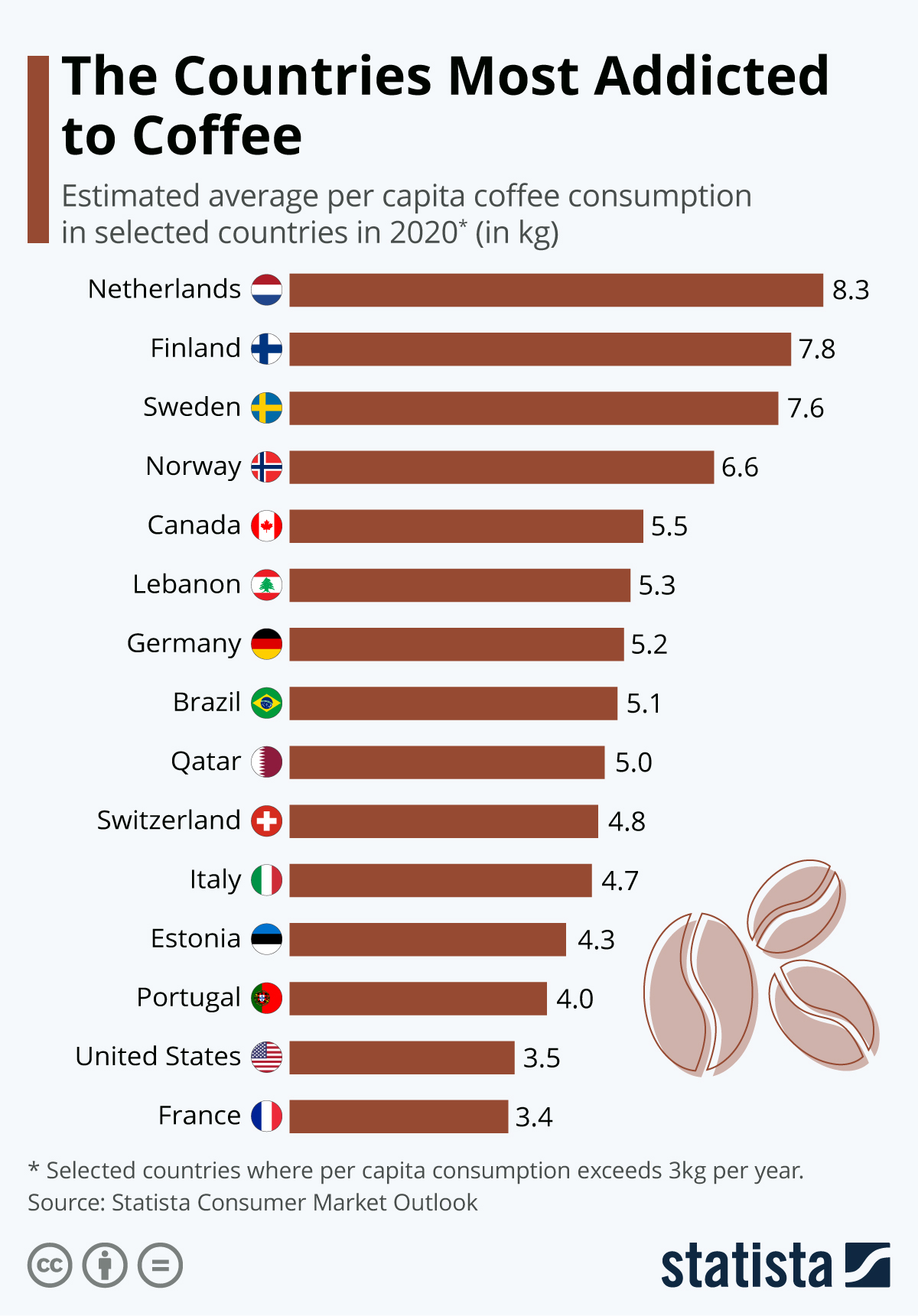 You will find more infographics at Statista
You will find more infographics at Statista
Origin
If your roaster knows where your coffee comes from, it’s more likely that it will be top quality. Why? Because coffee roasters can check sustainable growing practices. Additionally, they can perform better quality controls if they know where green beans come from.
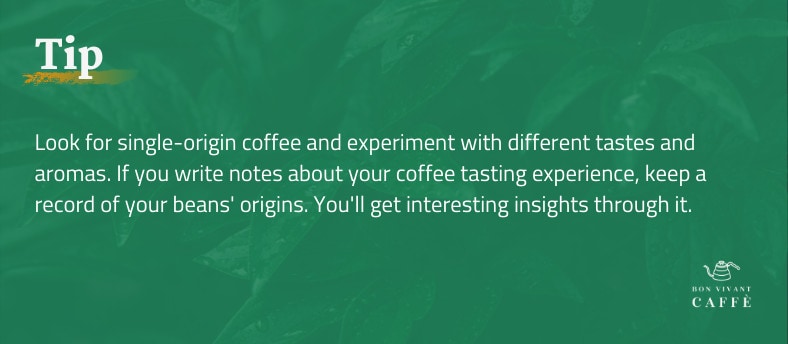
Additionally, traceability strengthens fair trade practices. As a result, coffee-growing businesses become more sustainable from an economic and environmental perspective. For this reason, the Specialty Coffee Association highlights traceability importance.
Green coffee doesn’t fall off the tree just like that. Growers pick ripe coffee cherries, ferment them, and dry the coffee beans at their origin.
Although it’s common to use harvesting machines in Brazil, most coffee producers hire people to do this work manually.
Recently, Colombian coffee estates have started using machines. Yet, it’s hard to know if mechanized harvesting will affect quality negatively.
Coffee processing is another critical factor. Coffee growers ferment the cherries to get coffee beans. As you might know already, experts classify coffee processing into three types: natural, washed, and honey.
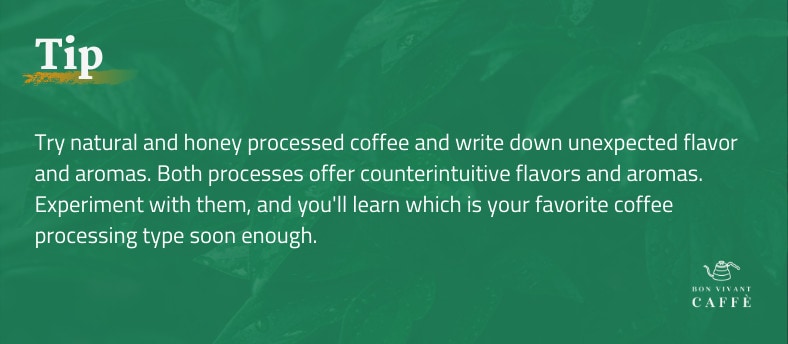
Each processing type has a massive influence on aroma and flavor, and I recommend you try and compare them. It’s an entertaining way to develop sensory skills and elevate your coffee experience.
Overall, a cool and geeky thing about traceable coffee is that you can learn more about varietals, terroirs, and coffee processing. Learning about it helped me to identify different aromatic profiles.
I can’t forget the first time I tasted an Ethiopian Yirgacheffe, as well as my first Venezuelan specialty-level cup of coffee.
Please be warned; traceable coffee is less affordable than commodity coffee. Yet, I am sure that’s completely worth it.
Roasts
Roasting is a huge deal for coffee. Most of us learn to drink over-roasted coffee. Moreover, before knowing anything about specialty coffee, I thought the best coffee was oily and dark.
Later on, I learned to appreciate the whole roast spectrum, from light to dark. Yet, as shocking as it was for me, I found out that oily beans aren’t good at all. I learned about it thanks to Matt Kellso’s insightful article.
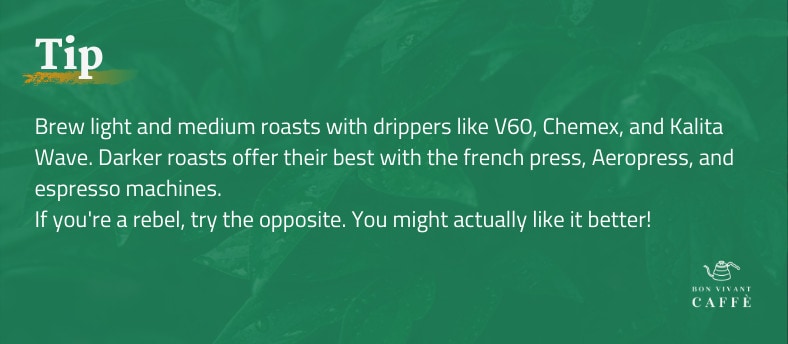
Coffee roasting is a delicate art that has advanced over decades. With technical progress, roasting has become more sophisticated. Currently, thousands of boutique coffee roasters around the world offer top-quality coffee.
One of the best things – and the easiest – I did to improve my coffee experience was to buy from local coffee roasters. Talking with them is as good as specialty coffee training.
Interestingly, medium and light roasts tend to offer acidic, sweeter, and more complex aromatic profiles than dark ones. Furthermore, tasting them for the first time can be a bit shocking!
Freshly Ground Coffee
If you want great coffee, you’ll grind it on demand.
At first, you might think I am exaggerating. Still, you should give it a try. Although experts claim that freshly ground coffee isn’t for everybody, I firmly believe it’s a lot better. You can read my piece about freshly ground coffee here.
However, grinding coffee at home can be challenging. Low-quality grinders can produce terrible results. Indeed, it can be better to buy freshly ground coffee at your favorite coffee roastery. So, if you choose to grind coffee at home, get a good grinder. Why would you have a coffee grinder at home? Well, freshly ground coffee features:
- More intense aroma and flavor
- A richer and more complex aromatic profile
- Less free radicals and more antioxidants
- Self-guaranteed 100% coffee
- You can grind your coffee beans at your preferred size
The latter feature takes me to the next point about freshly ground coffee. Depending on your brewing device, you can adjust your coffee recipes based on coffee bean grind size.
Currently, I have an Aeropress, V60, French Press, and a Moka Pot. I know, first hand, that it’s better to adapt grind sizes to your brewing methods.
Brewing Methods
Curiosity and persistence are essential for learning. And believe me, improving your coffee experience implies a lot of knowledge.
Some of the most interesting -and frightening- things about specialty coffee are the diversity and complexity of brewing methods.
I feel like we have a new brewing device waiting to try it. Moreover, coffee brewing technology has advanced during the last few years, especially for home brewing.
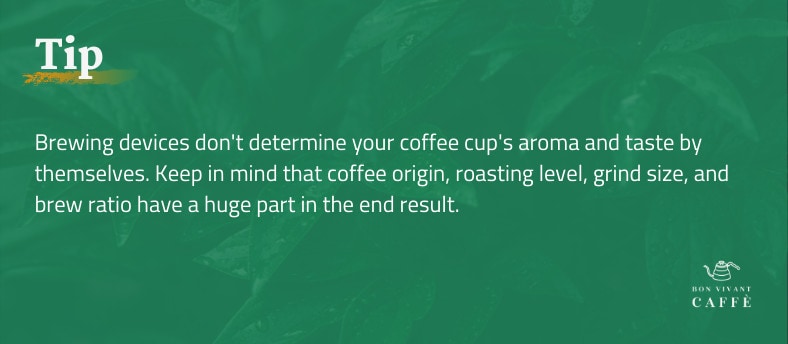
If you want to enjoy coffee more than you are enjoying right now, you should learn brewing methods.
My coffee experience changed after I learned the SCA brewing methods standards.
Most of the tips I am sharing result from practicing the SCA standards and personal experimentation. I like to think the only golden rule for coffee-loving is personal taste. Yet, the more I know about coffee, the richer and more rounded my personal preferences are.
Coffee Tasting and Enjoyment
Thousands of people work to make our cup of coffee possible. Learning to appreciate coffee quality is a way to honor their skills and effort. Furthermore, knowledge empowers us to improve our coffee drinking experience, one step at a time.
Discerning the best of coffee and identifying defective beans is professional work. It’s a legitimate and exciting career, but learning the most basic sensory skills will help you enjoy your coffee.
I started identifying acidic, bitter, and sweet notes. Today I can notice the chocolate, fruity, and floral notes as I grind, smell, and drink coffee at home. However, it took further practice to get there.
To develop your nose and palate, write down the aromas and tastes you perceive. Before taking notes, let’s cover the basics of organizing your coffee tasting notebook.
Aroma
It would be a truism to say that coffee smells good. Coffee lovers tend to speak about the most magical’s smell in the world as the aroma.
Yet, coffee aroma isn’t only about the smell. It refers to flavor and mouthfeel as well.
Our nose deals with most of our tasting ability. Although many people would say that coffee smells better than it tastes, both experiences are inseparable.
Indeed, drinking coffee when our noses are shut off due to strong odors, the flu, or allergies makes no sense.
In short, coffee aroma is our olfactory perception of the combination of coffee smell and flavor when we drink it. Expressions like aromatic profiles and notes refer to discernable aspects of coffee.
For beginners, it’s one of the most challenging and frustrating bits about specialty coffee. I know how it feels to taste “just coffee” after reading a label with seductive words like floral, redberry, or chocolate notes.
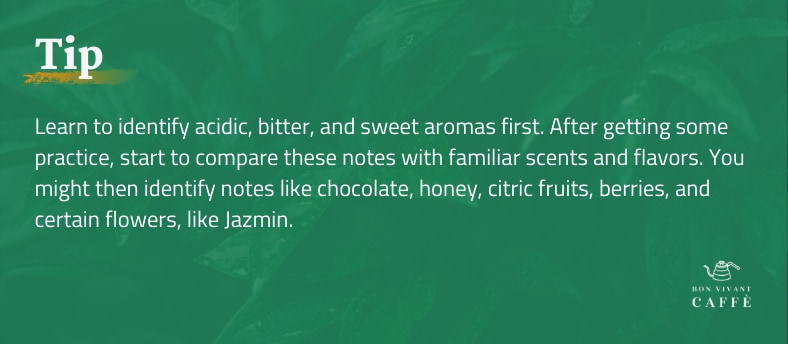
Flavor wheels have been crucial for coffee quality controls over the past 20 years. Moreover, anyone who wants to improve coffee sensory skills can find flavor wheels helpful.

Visuals
Almost immediately after smelling coffee, we serve it and enjoy it with our eyes. We can watch bubbles while brewing with a dripper. Or we can see a seductive layer of crema on top of an espresso. Furthermore, the darkness and density of the coffee drink are pleasurable aspects we can contemplate too.
Milk-based coffee drinks like the cappuccino, flat white, and cafe latte can display latte art on top. Toppings like chocolate shavings, cinnamon powder, and caramel syrups improve our coffee appeal in taste and appearance.
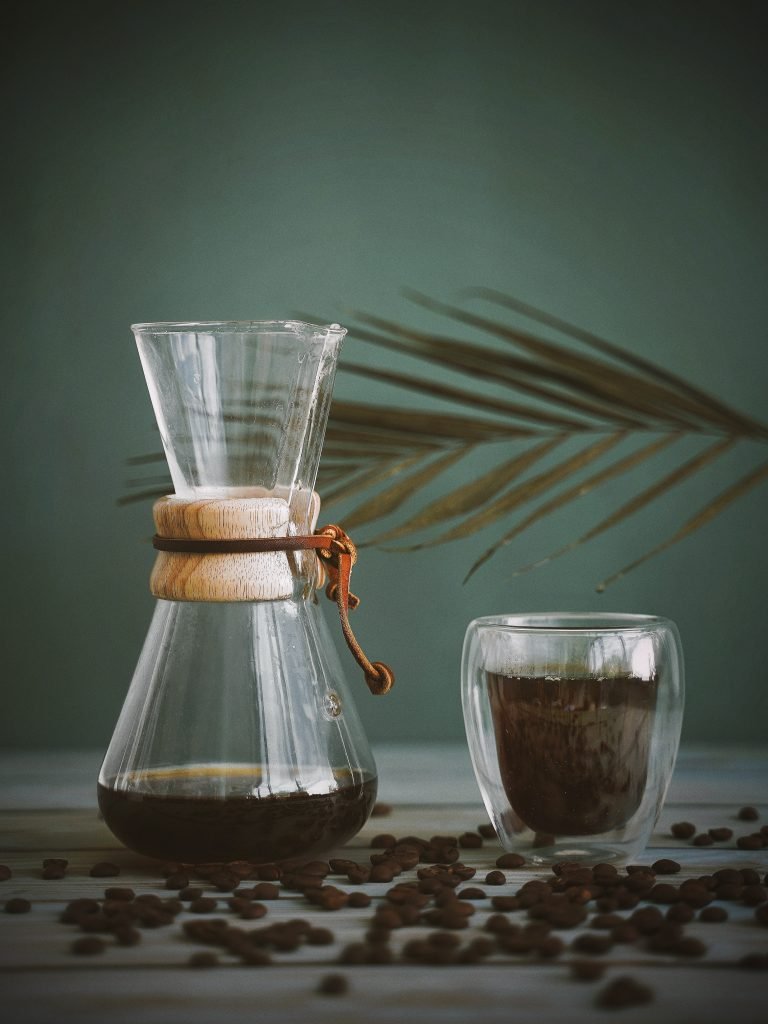
Finally, coffee suggests his body through its visual aspect before we can experience it as a whole. It’s easy to see the difference between an espresso and a Chemex-filtered coffee. The first will show an oily consistency and pitch-black color. Depending on the roasting level, the second can look watery and dark, with some brown and reddish tones.
Body
![[Tip: body depends on brew ratio and brewing devices. Experiment with affordable brewing devices like the french press, Moka pot, and V60 to learn which is your favorite coffee body type]](https://www.bonvivantcaffe.com/wp-content/uploads/2021/02/tip-coffee-body.jpg)
It sounds odd to talk about a drink’s body, but coffee displays a pleasant mouthfeel we can’t ignore. Most experts claim that we can identify three different types of coffee bodies.
Light
Although counterintuitive at first, lightly bodied coffee can allow you to enjoy a wider variety of aromatic notes in a single cup. It feels more like water and looks pretty clean. When we see it through a glass cup, we find little or no residue, and the texture isn’t different from water.
Medium
Like most things coffee, a medium body is hard to understand without trying the extremes. Heavier than your clean Chemex-filtered brew lighter than your meanest espresso shot.
The medium body isn’t merely halfway between heavy and light. It’s more a fuzzy range between the lightest and heaviest coffee bodies.
Heavy
A heavy body is rich in texture and mouthfeel, usually with a strong aroma and dominant notes. The heavy body looks thick, intense, sometimes creamy, and consistently dense. It’s your meanest espresso shot, a slowly French-pressed mug, or your Turkish-style coffee cup.
Aftertaste
Luckily, when we drink great coffee, it doesn’t vanish from our senses. Moreover, our mouth, throat, and the high esophagus preserve some taste and aroma.
According to experts, what we commonly refer to as after taste is after-flavor because it’s the combination of taste and aroma.
I must acknowledge that coffee aftertaste isn’t the best part of drinking it. At least for me. I enjoy the coffee scent when grinding it, much more than its aftertaste.
Still, it’s pleasant. Furthermore, it’s an essential part of enjoying coffee. Identifying acidic, fruity, bitter, and even oily notes adds to the coffee experience.
Are these the best coffee hacks out there?
I’m sure that learning about Specialty Coffee helped me improve my daily routine. My most valuable treasure is all the tips, tricks, concepts, and principles I shared in this article.
Great coffee is much more than a seductive and complex aroma. Yet, elevating your coffee experience is a gradual, pleasant process in itself.
As coffee lovers, we are at the receiving end of the so-called “Coffee Value Chain.” In my experience, drinking coffee becomes a more fulfilling and enjoyable experience as I learn more about it.
I hope you enjoyed the article and find it useful to enrich your own coffee experience.
Share it with your fellow coffee lovers!



